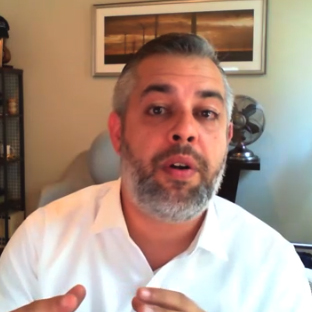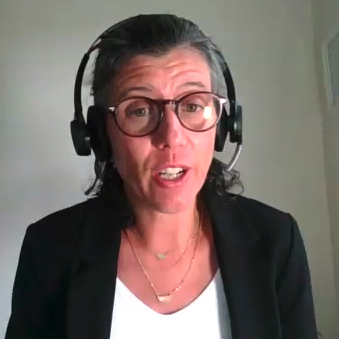
NERC has not yet issued its annual Winter Reliability Assessment, but it is already clear that it is concerned about the electric industry’s readiness to withstand severe and unpredictable weather this winter.
“We’re requesting early adoption of some of our cold weather standards,” said John Moura, director of NERC’s reliability assessment and performance analysis, at the start of the ERO’s annual winter preparation webinar on Thursday.
 John Moura, NERC | NERC
John Moura, NERC | NERCMoura said that in 2021 the industry experienced 70 hours of unplanned load shedding because grid operators had no other options.
“This is a trend we have seen over the last couple of years: more times where the system is under duress and has to initiate energy alerts [that] has led to operator-initiated load shed,” he said. “This is kind of a trend that we really need to reverse.”
A NERC analysis of outages from 2013 through 2021 shows that all generation types other than nuclear have experienced an increase in forced outages during cold weather, he said. That includes traditional baseload coal and gas plants, said Moura, adding that gas storage is currently at the low end of the five-year average and coal inventories are lower than they should be at some power plants, making them vulnerable to railroad worker strikes or other events that could reduce resupply.
NERC is urging “cross industry engagement” to ensure gas and coal plants do not experience fuel shortages this winter.
“Even if we were to winterize all our units, and we had perfect reliability, we will still have in some places concerns with the availability of fuel and the reliability either of the pipeline system or other energy delivery systems. I think that that only can be fixed … when we work and plan together,” Moura said.
 Mark Olson, NERC | NERC
Mark Olson, NERC | NERCMark Olson, manager of reliability assessment at NERC, said the organization will soon release a cold weather alert with recommendations for this winter. He added that “coal stockpiles have been at a historic low level.”
Explaining that the goal of Thursday’s webinar was “to help get the ball moving” before NERC publishes its 2022/23 Winter Reliability Assessment in November, Olson acknowledged that the industry is already preparing for winter.
“I know there’s a lot being done, and so we’re not really initiating action here as much as we’re emphasizing and sharing the insights from the past,” he said, acknowledging that NERC is aware that “generators are taking steps and need to continue those steps to be proactive and prepare for the winter.”
Olson also said that “grid operators need to prepare and do drills for cold weather plans and for things like load shedding so that they can be efficient and minimize disruption as much as possible to end users while preserving the reliability of the overall system.”
 David Lemmons, Greybeard Compliance Services | NERC
David Lemmons, Greybeard Compliance Services | NERCTwo areas of special concern are the MISO footprint and Texas, he said.
In MISO, “our preliminary data indicates there’s about 7 GW of coal generation and 1 GW of nuclear generation that has retired from last winter. And that’s led to a declining reserve margin,” he said, which could become a serious problem in an extremely cold winter.
David Lemmons, an independent analyst and co-founder of Greybeard Compliance Services, stressed the importance of detailed information sharing and close cooperation between generators and grid operators, particularly during extraordinary weather events.
Examples North and South
Webinar participants also heard about extreme weather preparations from Canada’s largest electric utility, Hydro-Quebec, and El Paso Electric. Both utilities experienced severe weather-related service disruptions in the past and had to develop practices and technologies that have enabled them to function in extreme weather.
Anne-Marie Fournier, a regulatory affairs expert and reliability coordinator at Hydro-Quebec, said annual reliability assessments that begin in May have helped the company develop strategies to deal with potential weather catastrophes when demand normally peaks.
“A very important part of preparing for winter and improving the way we prepare is by looking back at how we have performed,” she said.
“We learn a lot from past events, and sometimes we learn the hard way,” she said. “That was the case with the 1998 ice storm that hit south of Quebec. We received more than 3 inches of freezing rain spread over five days. That freezing rain was very heavy and made 24,000 utility poles and 900 steel poles collapse.”
 Anne-Marie Fournier, Hydro Quebec | NERC
Anne-Marie Fournier, Hydro Quebec | NERCNearly 1.4 million customers lost power, for up to four weeks in some areas. Montreal was without power for two days, crippling the metro transit system and the water filtration system as well, she said. Then temperatures dropped into a “deep freeze,” she said, leaving most customers without heat because homes and businesses are heated electrically.
The company has since built “anti-cascading” transmission towers to limit the extent of line damage if a tower collapses, built additional lines and installed de-icers on certain lines. Hydro generators are located inside heated buildings with backup auxiliary heating; spillways are heated electrically; and dams are designed to withstand ice formations.
Fournier said the annual spring assessment moves to a load forecast in July and an updated inventory and “formal identification” of all available internal resources in August. Another resource adequacy check, including potential power imports and exports, gets under way in September, as well as the running of several scenarios simulating the coming winter’s projected peak demand.
In October, a planning team validates available interruptible loads and the amount of power available that those customers could provide the company if needed. Final equipment checks and operator training happens in November, she said, before demand begins to surge in early December.
“During the peak period, we have a cross-functional team that meets daily to make sure everything is handled. And this team is constituted of people from the transmission side, the generation side and the distribution side. Our teams of meteorologists and load forecasters are very busy also at wintertime as they sometimes monitor load and weather closely for 24 hours a day, seven days a week,” she said.
Kyle Olson, director of generation and asset management at El Paso Electric, said a major reason the company survived the February 2021 storm is that it did not do well in a major storm 10 years earlier.
That storm knocked out one of the company’s aging power plants, leading to rolling blackouts. The utility turned to Black and Veatch for recommendations on how to improve its performance.
“We invested over $4.5 million in freeze protection upgrades at what were only two local plants at the time. These upgrades included heat tracing insulation and other winterization tools,” he said.
The company also developed hot and cold winterization checklists, procedures and preventative maintenance strategies, and “new design criteria” for construction of new power plants capable of operating at temperatures as low as -10 degrees Fahrenheit and as high as 105 F.
“We also factored in wind and humidity. It tends to be the high wind and the humidity that ends up biting us during the cold events more than just the actual cold temperatures,” Olson added.
In the decade between the two storms, the company replaced its coal generation with gas turbines, the newest of which it plans to run on 30% hydrogen by 2045 through an agreement with turbine maker Mitsubishi Power. The utility is also aiming to build large solar arrays backed up by Mitsubishi gas turbines.
Olson said the company installed freeze-protection equipment for critical controls at its new gas turbines plants. That included the use of “O’Brien Boxes,” protective, often heated, enclosures designed to keep controls, instruments and even tubing warm and operable at low temperatures.
The company has opted to build simple cycle gas turbine plants rather than the more efficient combined cycles, which require water heated by the waste heat of the gas turbines to run secondary steam turbines.
“We are in a desert,” Olson explained, “but also because [simple cycles] perform well during severe winter events,” such as the 2021 storm when temperatures in the region fell to 14 F.
The company’s newest plant has dual-fuel capability, he said, another strategy to make certain the plant can stay online during emergencies.
The company also contracts for more than 600 MW from the Palo Verde nuclear plant in western Arizona. “During the 2021 storm, Palo Verde was essential to meeting our customer loads and avoiding price spiking,” said Olson.
